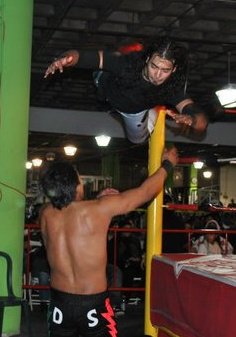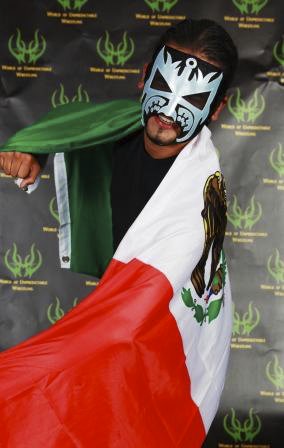 Born in Mexico, but raised in Brooklyn, New York, 19-year-old Jorge Beltran is a walking duality. Inspired and influenced by both his Mexican heritage and American culture, Beltran is able to incorporate them into his career.
Born in Mexico, but raised in Brooklyn, New York, 19-year-old Jorge Beltran is a walking duality. Inspired and influenced by both his Mexican heritage and American culture, Beltran is able to incorporate them into his career.
An up and coming professional wrestler, Beltran is able to use the high flying moves his countrymen have made famous, as well as the fast-paced and stiff American style that millions of people in the US watch every week. In just five short years, he has wrestled in various independent promotions all over the country such as Dragon Gate USA, World of Unpredictable Wrestling, and East Coast Pro Wrestling.
However, in a swerve that would likely only be seen in a wrestling storyline, Beltran recently moved back to Mexico in order to continue his dream of performing at the same places he marveled at as a child- in spite of several opportunities in the states.
In this exclusive Q & A, Beltran discusses how he got bit by the wrestling bug, as well as the moves he performs in the ring. He also discusses how trust and teamwork play a much bigger part of a wrestling match than you might think.
Review Fix: When did you decide you wanted to become a professional wrestler?
Jorge Beltran: I was living in Mexico at the time. I was like five or six and I began watching the televised AAA Mexican wrestling shows. After a few weeks, I got hooked. I loved wrestlers like Octagón and Mascara Sagrada. They were really good and I immediately said to myself that I wanted to do that one day. However, even though the idea was in my head at that point, I was obviously still just a little kid that watched stuff like Barney and Power Rangers and I wasn’t completely sold. But when I came to the United States a few years later, that’s when I started watching WWE and WCW and started to get into the sport even more. By 2001, just when WCW was closing up, I told my parents that this was something I wanted to do.
RF: How did they react to the news?
Beltran: They were really supportive, but they told me that it would very hard to find a wrestling school in New York. I then started looking around and found schools in New Jersey, Pennsylvania and North Carolina, but not in Brooklyn. It was hard because I knew my parents weren’t going to be able to drive me around everywhere. At that point, I got really sad. I’d even cry sometimes wondering if I was ever going to get the chance to wrestle. I had no one to train me.
RF: What happened next?
Beltran: My mother threw the idea of boxing to me and said that it was a tough sport and it was real, so for a little while, I was thinking about doing that instead. So I went down to Gleason’s Gym under the Manhattan Bridge in the DUMBO area of Brooklyn. When I went inside, I saw five rings and one of them had three ropes. It caught my attention because boxing rings have four ropes, so I was wondering what was going on there. I saw a sign that was promoting wrestling and I was immediately happy. I went to the front desk and asked for more information and I found out that WWE Hall of Famer Johnny Rodz taught there. That’s how it all started. I was just 14 years old.
RF: After spending five years training with Johnny Rodz and traveling all over the East coast of the United States, you decided to go back to Mexico to work. Why?
Beltran: I always wanted to go to the WWE when I was younger, but now it’s different with all the marketing, loud music and fireworks. I just want to wrestle and I want to perform in the places that I watched when I was a child here. Mexican wrestling hasn’t changed nearly as much as it has in America. Plus, all my first memories of the industry are here and I figured this would be a great place to train and try my luck. So far, it’s been great.
 RF: In your time in the United States, you sometimes wore a mask. It’s something you might also do in Mexico as well. What is it like to perform in the ring like that? Is it hard to see?
RF: In your time in the United States, you sometimes wore a mask. It’s something you might also do in Mexico as well. What is it like to perform in the ring like that? Is it hard to see?
Beltran: It’s not that difficult, but it all depends on the type of mask you have. The mask I wrestled with wasn’t made by a professional mask maker so sometimes it shifted and moved during the match. Sometimes, depending on whom you’re wrestling with, they’ll get too rough and loosen the mask, which is a problem too. Overall though, it wasn’t anything too crazy, you just have to be careful.
RF: Tell us about some of the moves you do in the ring.
Beltran: Most of it is high-flying stuff. That’s really the reason why I came down to Mexico, to learn Lucha Libre. I do a lot of things off the top rope. My finisher is a DDT that is a little different in the fact that I jump off the top rope and then grab the guy by the neck on my way down. I don’t do a 450 because a lot of other wrestlers do it, but I can do it if I have to. I use the moonsault regularly and do some planchas as well. With that, I incorporate a sit down scoop slam and plenty of kicks, which is more of a Japanese style. I’m a small guy, so just to give you a better idea of what I do in the ring, if I was facing someone huge like the Undertaker, I’d wrestle like a Rey Mysterio, using the types of moves he does, but mix in some Yoshihiro Tajiri and work in some kicks.
RF: Everyone knows that wrestling is choreographed, but as you can’t fake gravity. The moves hurt. In order to not get hurt, you have to have trust in your opponent. Can you describe that process?
Beltran: The way it works is the person with more experience usually calls the match. The better the relationship you have, the more they’ll allow you to be creative with them. Most of the time, you can tell who’s professional and who’s not just by talking to them. Every move hurts both guys if done improperly and every guy wants to look good, so it’s a bargaining process involving body language, politics and trust. I know that sometimes I wouldn’t do certain moves with some guys that I would do with others simply because I didn’t know if they could protect me or make it look the way it should. All of that goes into how a match is put together.
RF: What’s it like in the locker room before a match?
Beltran: It’s usually loud and guys are talking about their matches and introducing themselves. It’s a different type of environment built on respect. You get somewhere in wrestling by being both talented and respectful to the people that go into the ring before and after you. I always pride myself on being kind to everyone I’m in the ring with.
RF: Why do you think you’re willing to put your body through so much?
Beltran: It comes with the job. After every match, everything is sore, you get bumps and bruises, but that’s part of the game. Plus, once your music hits and you walk to the ring, all your pain goes away; it’s that type of rush. You forget about everything. Sometimes it comes to my mind- why I would do this to myself for other people’s amusement? I try not to think about it like that though. My heart is always pumping knowing that I can do this because I’ve wanted to do it since I was five. It’s crazy that I’m here wrestling in Mexico; this is what I wanted. This is really big for me.


Leave a Reply